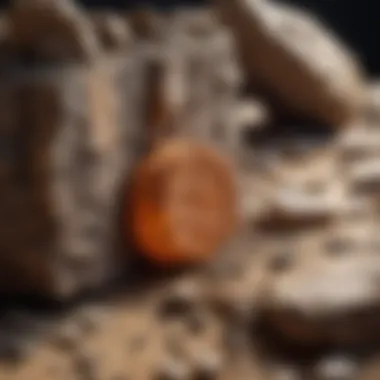Unveiling the Complexities of Rock Testing: A Deep Dive into Geological Analysis


Rock and Fossil Identification
In the realm of rock testing, the identification of various rock types and fossils is a foundational aspect that sets the stage for in-depth analysis. Understanding the types of rocks and fossils one may encounter, recognizing key characteristics to look for, and utilizing appropriate tools for identification are paramount. Differentiating between igneous, sedimentary, and metamorphic rocks, as well as distinguishing between various types of fossils, provides essential context for subsequent testing procedures. By carefully observing color variations, grain sizes, and unique structures within rocks, collectors and researchers can glean valuable insights into their formation and geological history. Moreover, employing tools such as hand lenses, hardness picks, and magnifying glasses aids in the meticulous examination of minute details, enhancing the accuracy of rock and fossil identification.
Collecting Tips and Techniques
Efficiently collecting rock and fossil specimens requires a blend of methodology, skill, and caution. For enthusiasts eager to embark on collecting expeditions, adherence to best practices is crucial. Identifying prime collecting sites characterized by geological richness and accessibility is the first step towards successful specimen acquisition. Delving into geological maps, researching renowned fossil sites, and collaborating with local experts can significantly enhance the prospect of discovering exceptional specimens. Additionally, mastering the art of safely extracting specimens without causing damage or altering their integrity demands precision and patience. Utilizing tools such as chisels, rock hammers, and brushes with finesse ensures the preservation of delicate structures and enhances the overall collecting experience.
Preservation and Display
Upon procuring specimens, the meticulous preservation and creative display of rocks and fossils become essential endeavors. Implementing proven techniques for preserving specimens, including cleaning methods, consolidants, and protective storage measures, is pivotal in maintaining their pristine condition for long-term study. Adopting proper storage methods, such as utilizing acid-free containers, moisture-control packets, and display cases with UV protection, safeguards specimens from degradation and environmental hazards. Furthermore, exploring creative display ideas in both personal collections and educational settings adds a layer of aesthetic appeal and educational value, captivating viewers and fostering a deeper appreciation for the geological wonders encapsulated within each rock or fossil.
Geological Insights
Delving into the world of rock testing unveils profound geological insights, shedding light on the intricate formations and processes that have shaped our planet over millions of years. Exploring geological formations and processes provides a lens through which to comprehend the dynamic forces at play beneath Earth's surface, influencing the structures and compositions of rocks and fossils we encounter. Unpacking the historical significance of rocks and fossils illuminates the narratives of past environments, ancient life forms, and evolutionary trajectories, offering a kaleidoscopic view of Earth's geological history. Additionally, delving into notable discoveries in the field of geology underscores the pivotal contributions of rock testing in unveiling groundbreaking insights, driving scientific inquiry and expanding our understanding of the natural world.
Introduction to Rock Testing
Rock testing is a crucial aspect of geology that plays a significant role in unraveling the mysteries hidden within rock formations. By examining the composition, properties, and geological significance of rocks, researchers can gain valuable insights that aid in understanding the Earth's history and dynamics. Through a combination of laboratory analyses and field tests, a comprehensive understanding of rocks can be achieved, enabling geologists and enthusiasts to delve deep into the intricate details of our planet's structure and evolution. This section will explore the various elements and considerations surrounding rock testing, shedding light on its importance in geological studies.
Understanding the Significance of Rock Testing
Analyzing Rock Formation Processes
One of the primary aspects of rock testing is analyzing the processes involved in the formation of rocks. This step is crucial as it allows researchers to decipher the environmental conditions, pressure, and temperature that contributed to the formation of specific rock types. By studying the formation processes, geologists can unveil clues about the geological history of an area, providing essential information for further research and interpretation. Analyzing rock formation processes is a fundamental part of rock testing, offering insights that help in understanding the Earth's complex mechanisms.
Identifying Mineral Composition
Another essential aspect of rock testing is identifying the mineral composition of rocks. This process involves analyzing the types and proportions of minerals present in a rock sample, guiding researchers in determining its origin and characteristics. By pinpointing the mineral composition, geologists can draw connections to different rock formations, aiding in geological mapping and resource exploration. Understanding the mineral composition is key to interpreting the properties and behavior of rocks, making it a valuable component of rock testing.
Evaluating Physical Properties
Evaluating the physical properties of rocks is a critical step in rock testing that provides insights into their strength, durability, and overall behavior. By conducting tests to measure density, porosity, compressive strength, elasticity, and hardness, researchers can assess the structural integrity and stability of rocks. These evaluations are essential in various industries, including construction, mining, and engineering, where knowledge of rock properties influences project planning and execution. Understanding the physical properties of rocks enhances our understanding of their potential applications and limitations, highlighting the significance of this aspect in rock testing.
Purpose and Benefits of Rock Testing
Determining Geological History
Determining the geological history of an area is a primary objective of rock testing. By studying the composition and structure of rocks, researchers can unravel the geological processes that shaped the landscape over millions of years. Understanding the geological history provides crucial insights into past environmental conditions, climate variations, and tectonic movements, contributing to a comprehensive understanding of Earth's evolution. Rock testing plays a vital role in piecing together the intricate puzzle of geological timelines, offering valuable information for academic research and practical applications.
Assessing Rock Stability
Assessing the stability of rocks is essential in various fields, including civil engineering, mining, and geotechnical studies. By evaluating factors such as fracturing, weathering, and structural integrity, researchers can assess the stability of rock formations and predict potential hazards. Rock stability assessments are crucial for infrastructure projects, slope stability analyses, and landslide predictions, highlighting the importance of this aspect in rock testing. Understanding the stability of rocks enables informed decision-making and risk mitigation strategies, emphasizing its significance in geological studies.


Facilitating Resource Exploration
One of the key benefits of rock testing is its role in facilitating resource exploration. By analyzing the composition, properties, and distribution of rocks, researchers can identify potential mineral deposits, hydrocarbon reserves, and groundwater resources. Rock testing techniques aid in mapping subsurface geology, guiding exploration activities in mining, oil and gas, and water management industries. Facilitating resource exploration through rock testing enhances our ability to harness natural resources sustainably, promoting economic development while minimizing environmental impact. The strategic use of rock testing techniques is instrumental in resource management and conservation efforts, underscoring its importance in geological investigations.
Scope of Rock Testing Techniques
Laboratory Analysis
Laboratory analysis forms the bedrock of rock testing, providing researchers with precise data on rock composition and properties. Through techniques such as X-Ray Fluorescence (XRF), Inductively Coupled Plasma (ICP), and Mass Spectrometry, geologists can analyze the chemical composition of rocks with high accuracy. Laboratory analysis also involves sample preparation, thin section microscopy, and mineral identification, offering detailed insights into rock characteristics. This section will delve into the intricacies of laboratory analysis techniques, highlighting their benefits in studying the fundamental properties of rocks.
Field Testing Methods
Field testing methods are essential for examining rocks in their natural environment, providing on-site data collection and analysis. Techniques like grab sampling, core drilling, and trenching offer insights into rock behavior, weathering patterns, and structural features. Field tests complement laboratory analyses by validating findings in real-world conditions, enhancing the reliability of research outcomes. Understanding the principles and applications of field testing methods is crucial for geologists and field researchers, expanding the breadth of knowledge in rock testing practices.
Advanced Analytical Tools
In the realm of rock testing, advanced analytical tools play a pivotal role in enhancing research capabilities and analytical accuracy. Technologies such as aerial imaging, hyperspectral analysis, and Lidar mapping offer innovative ways to study rock formations with precision. Digital modeling techniques like Finite Element Analysis, Computational Fluid Dynamics, and Geostatistical modeling provide in-depth insights into rock behavior, structural mechanics, and geological processes. The integration of advanced analytical tools revolutionizes rock testing practices, fostering new discoveries and methodologies in geoscience research. This section will explore the cutting-edge technologies transforming the landscape of rock testing, unlocking new frontiers in geological exploration and scientific knowledge.
Laboratory Analysis of Rocks
In this detailed exploration of rock testing intricacies, the focus turns to Laboratory Analysis of Rocks. This section holds paramount significance in understanding the composition, properties, and geological relevance of rocks. The meticulous process of laboratory analysis allows geologists, researchers, and enthusiasts to unravel crucial insights hidden within rocks. By delving into laboratory analysis, one can uncover the detailed characteristics of rocks, aiding in comprehending their formation history, stability, and potential resource exploration opportunities.
Sample Preparation and Examination
Coring and Cutting Techniques
Coring and Cutting Techniques play a pivotal role in the Laboratory Analysis of Rocks. These techniques involve extracting cylindrical rock samples through drilling (core drilling) or obtaining thin sections of rocks by cutting them precisely. The key characteristic of Coring and Cutting Techniques lies in their ability to preserve the integrity of the rock samples, ensuring minimal alteration during the extraction process. The precision offered by these methods makes them a popular choice for studies requiring intact rock samples for thorough analysis. However, challenges such as tool wear and sample contamination can be encountered, impacting the reliability of results.
Thin Section Preparation
Thin Section Preparation is a fundamental aspect of rock testing, especially in laboratory settings. This technique involves slicing thin rock samples, typically less than 30 microns thick, for microscopic analysis. The key characteristic of Thin Section Preparation is the creation of transparent slides that allow for detailed examination of mineral composition and texture under a petrographic microscope. This approach is favored for its high level of detail provided, essential for identifying minerals and understanding rock fabric. Despite its advantages, challenges like preparation time and skilled labor requirements can pose logistical hurdles.
Microscopic Analysis
Microscopic Analysis is a cornerstone in the laboratory examination of rocks. This method involves studying rock samples at a microscopic level to identify mineral components, grain sizes, and structural characteristics. The key feature of Microscopic Analysis lies in its ability to unveil granular details not visible to the naked eye, offering insights into the rock's origin and formation processes. This technique is invaluable for geologists seeking to decipher the mineralogical complexities within rocks. However, limitations such as restricted field of view and potential sample damage during preparation must be carefully addressed.
Chemical Composition Analysis
Within the realm of rock testing, Chemical Composition Analysis plays a vital role in unraveling the molecular makeup of rocks. Techniques such as X-Ray Fluorescence (XRF), Inductively Coupled Plasma (ICP), and Mass Spectrometry offer detailed insights into the elemental composition of rocks. For instance, XRF utilizes X-ray radiation to determine elemental concentrations within a sample, providing rapid and non-destructive analysis capabilities. While advantageous for its efficiency, XRF may suffer from limitations in detecting elements of lower atomic number. Inductively Coupled Plasma, on the other hand, excels in analyzing trace elements with high precision, yet it requires elaborate sample preparation procedures. Similarly, Mass Spectrometry offers superior sensitivity for isotopic analysis but demands specialized training for interpretation and operation.
Physical Property Testing
Physical Property Testing is a critical phase in rock testing, aiming to quantify attributes like density, porosity, compressive strength, elasticity, and hardness. Measurements derived from these tests offer valuable insights into the mechanical behavior and structural integrity of rocks. Density and Porosity Measurements serve as fundamental indicators of rock mass characteristics, crucial for engineering and exploration purposes. Compressive Strength Testing assesses a rock's ability to withstand external forces and deformation, aiding in construction projects and geotechnical assessments. Meanwhile, Elasticity and Hardness Assessments provide a deeper understanding of a rock's deformation behavior and resistance to abrasion, essential for material classification and durability assessments.
Field Tests and In-Situ Examinations


Field tests and in-situ examinations play a pivotal role in rock testing, allowing geologists and researchers to gather valuable insights directly from rock formations in their natural environment. Conducting field tests offers a more comprehensive understanding of the structural integrity, composition, and behavior of rocks compared to laboratory analyses. By engaging in in-situ examinations, professionals can observe firsthand the geological features and phenomena that influence rock formation. This hands-on approach provides a deeper layer of information that complements data obtained through laboratory testing methods. Additionally, field tests allow for real-time analysis and decision-making, enabling immediate adjustments to the research process based on on-site observations.
Rock Sampling Techniques
Grab Sampling
Grab sampling involves collecting rock samples directly from the field at various depths or locations without the need for extensive excavation. This technique is especially valuable in areas where rapid assessments are required or where accessibility is limited. The key advantage of grab sampling lies in its ability to provide quick snapshots of rock composition and characteristics without complex equipment or prolonged preparation. However, grab sampling may present limitations in terms of representativeness, as samples are taken from specific locations and may not reflect the overall geological diversity of the area.
Core Drilling
Core drilling is a method that involves extracting cylindrical rock cores from different depths within a geological formation. This technique offers a more detailed and continuous view of the subsurface geology, allowing for precise analysis of various rock layers and structures. The key benefit of core drilling is its ability to provide intact and undisturbed core samples, preserving the natural orientation and sequential arrangement of rock formations. Despite its high accuracy and reliability, core drilling can be a time-consuming and resource-intensive process requiring specialized equipment and skilled personnel.
Trenching Methods
Trenching methods involve digging long, narrow trenches in rock formations to expose underlying layers for detailed examination. This technique is particularly useful for studying stratigraphy, fault lines, and the overall geological context of a site. By creating vertical or inclined trenches, researchers can directly observe and sample rocks at different depths, enabling thorough analysis of structural features and geological history. Trenching methods offer a comprehensive view of the subsurface environment but may require significant excavation work and careful documentation to ensure accurate interpretation of findings.
Geophysical Surveys
Seismic Refraction
Seismic refraction is a geophysical technique used to assess subsurface structures by measuring the velocity of seismic waves traveling through rock formations. This method is valuable for delineating bedrock profiles, detecting potential voids or fractures, and estimating geological layers' thickness. The main advantage of seismic refraction lies in its ability to provide continuous and non-invasive data, offering insights into subterranean geological properties without extensive drilling. However, seismic refraction may be less effective in highly heterogeneous formations or areas with complex subsurface conditions.
Ground Penetrating Radar
Ground-penetrating radar (GPR) is a geophysical method that uses electromagnetic radiation to image the subsurface features of rock formations. GPR is instrumental in identifying buried objects, mapping geological structures, and studying groundwater levels. One of the key advantages of GPR is its high-resolution imaging capability, allowing for detailed visualization of subsurface anomalies and variations. Despite its effectiveness in providing real-time data without disturbing the site, GPR's accuracy may be influenced by environmental factors such as soil conditions and electromagnetic interference.
Magnetic Susceptibility
Magnetic susceptibility measurements involve assessing the response of rocks to magnetic fields, providing information on their mineral composition and magnetic properties. This method is crucial for identifying magnetic minerals, characterizing geological structures, and tracing past environmental conditions. The main benefit of magnetic susceptibility analysis is its non-destructive nature, enabling rapid data collection without altering the rock samples. However, variations in magnetic susceptibility measurements may affect data interpretation, necessitating careful calibration and consideration of influencing factors.
On-Site Testing Procedures
Rock Hammer Analysis
Rock hammer analysis involves striking rocks with a geological hammer to assess their hardness, texture, and resistance to impact. This method helps geologists classify rocks based on their physical properties, aiding in mineral identification and geological mapping. The key advantage of rock hammer analysis is its simplicity and immediate results, allowing for quick field assessments and preliminary categorization of rock types. However, the subjectivity of hammer analysis and potential inconsistencies in hardness readings may impact result accuracy, requiring supplementary laboratory tests for validation.
Scratch Testing
Scratch testing involves using specialized tools to scratch rocks and assess their hardness and abrasion resistance. This method aids in determining the relative hardness of different mineral components within a rock sample, providing insights into its overall durability and composition. Scratch testing is particularly valuable for identifying mineral phases and evaluating rock quality for construction or industrial purposes. While scratch testing offers a low-cost and rapid evaluation technique, variations in user technique and tool sharpness may introduce inconsistencies in hardness assessments.
Acid Reaction Tests
Acid reaction tests involve applying acid solutions to rocks to observe their effervescent response, indicating the presence of specific minerals such as carbonates. This method helps in identifying mineral compositions, assessing rock weathering processes, and understanding geological alteration patterns. Acid reaction tests are valuable for quick mineral recognition in the field and can guide further detailed analyses. However, the interpretation of acid reactions may require additional laboratory confirmation due to potential interferences from environmental factors and the presence of multiple mineral types.


Advanced Techniques in Rock Testing
As we delve deeper into the realm of rock testing, the utilization of advanced techniques becomes paramount in unraveling the intricate details of rocks. Advanced Techniques in Rock Testing play a crucial role in this article by providing in-depth insights into the composition, properties, and geological significance of rocks. These techniques offer a sophisticated means of analysis that goes beyond traditional methods, enabling a more comprehensive understanding of rock formations. By employing Advanced Techniques, researchers can decipher complex geological data with greater precision and accuracy, shedding light on critical aspects that may have remained elusive with conventional approaches.
Remote Sensing Technologies
Remote Sensing Technologies represent a groundbreaking facet of rock testing, offering a non-invasive and efficient approach to gather valuable data. Within this domain, we explore three key aspects: Aerial Imaging, Hyperspectral Analysis, and Lidar Mapping.
Aerial Imaging
Aerial Imaging, characterized by its ability to capture high-resolution aerial photographs of terrain, plays a pivotal role in enhancing spatial analysis in rock testing. The unique feature of Aerial Imaging lies in its capacity to provide a bird's eye view of geological formations, enabling researchers to identify patterns and anomalies that may not be visible at ground level. While Aerial Imaging serves as a beneficial tool for geological surveys and mapping in this article, its limitations may include weather-dependent operations and cost constraints, which could impact its widespread application.
Hyperspectral Analysis
Within the realm of rock testing, Hyperspectral Analysis emerges as a cutting-edge technique that enables detailed spectral identification of mineral compositions. The key characteristic of Hyperspectral Analysis lies in its ability to analyze rocks at a hyper-specific level, identifying subtle variations in mineralogy that may go unnoticed by the naked eye or conventional methods. In this article, Hyperspectral Analysis proves to be a popular choice due to its capacity to provide precise data on rock composition, offering researchers a deeper understanding of geological processes. However, the complexity of interpretation and the need for specialized equipment may pose challenges in its utilization.
Lidar Mapping
Another instrumental tool in rock testing is Lidar Mapping, which utilizes laser technology to create detailed 3D maps of rock formations and terrains. The key characteristic of Lidar Mapping lies in its high accuracy in capturing topographical features and structural complexities, contributing significantly to geological investigations. While considered a beneficial choice for this article due to its precise mapping capabilities, Lidar Mapping may face limitations in densely vegetated areas or adverse weather conditions, affecting data acquisition and analysis.
Digital Modeling and Simulation
In the realm of rock testing, Digital Modeling and Simulation introduce a virtual dimension to the analysis, allowing researchers to simulate natural processes and conditions. Within this category, we delve into three main aspects: Finite Element Analysis, Computational Fluid Dynamics, and Geostatistical Modeling.
Finite Element Analysis
Finite Element Analysis serves as a powerful tool in rock testing, enabling researchers to simulate complex structural behaviors and stresses within rocks. The key characteristic of Finite Element Analysis lies in its ability to break down a rock mass into finite elements for detailed analysis, providing insights into deformation and stability parameters. In this article, Finite Element Analysis emerges as a popular choice due to its versatility in modeling various geological scenarios, aiding in the prediction of rock behavior. Yet, the computational intensity and expertise required in implementing Finite Element Analysis may pose challenges for widespread adoption.
Computational Fluid Dynamics
A critical component of rock testing, Computational Fluid Dynamics facilitates the study of fluid-rock interactions and dynamics within geological formations. The key characteristic of Computational Fluid Dynamics lies in its ability to model fluid behavior, such as groundwater flow or magma movement, in relation to rock structures. In this article, Computational Fluid Dynamics proves beneficial for simulating intricate geological processes, offering insights into fluid-rock interactions. However, the complexity of parameters and the need for extensive computational resources may restrict its application in certain research settings.
Geostatistical Modeling
Geostatistical Modeling encompasses the spatial analysis of geological data, aiding in the interpretation and visualization of rock properties. The key characteristic of Geostatistical Modeling lies in its capacity to analyze spatial patterns, variability, and uncertainties within rock formations, facilitating resource evaluation and risk assessment. In this article, Geostatistical Modeling emerges as a valuable choice for understanding the distribution of rock properties, guiding decision-making processes in geological studies. Nevertheless, the need for robust statistical techniques and data validation measures may present challenges in implementing Geostatistical Modeling effectively.
Emerging Trends in Rock Testing
As we look towards the future of rock testing, Emerging Trends usher in a new era of innovation and exploration. Within this domain, we explore three significant aspects: Nanotechnology Applications, Machine Learning Algorithms, and Blockchain Integration in Geology.
Nanotechnology Applications
Nanotechnology Applications revolutionize rock testing by offering precision at the nanoscale level, enabling detailed analysis of rock structures and compositions. The key characteristic of Nanotechnology Applications lies in their ability to manipulate and characterize rocks at a molecular level, providing insights into nanostructures and surface properties. In this article, Nanotechnology Applications stand out as a beneficial choice for enhancing understanding of rock behaviors and interactions, fostering advancements in geological research. However, the need for specialized equipment and expertise in nanoscience may present barriers to widespread adoption.
Machine Learning Algorithms
Within the realm of rock testing, Machine Learning Algorithms present a data-driven approach to analyze vast datasets and extract meaningful patterns. The key characteristic of Machine Learning Algorithms lies in their ability to identify correlations and anomalies within rock data, facilitating predictive modeling and data interpretation. In this article, Machine Learning Algorithms offer a valuable tool for processing complex geological data efficiently, assisting researchers in uncovering hidden insights. Nonetheless, the requirement for quality data inputs and continuous model training may pose challenges in deploying Machine Learning Algorithms effectively.
Blockchain Integration in Geology
Integrating blockchain technology into geology opens up opportunities for secure data management and traceable transactions in rock testing procedures. The key characteristic of Blockchain Integration in Geology lies in its decentralized and tamper-proof nature, ensuring the integrity and transparency of geological data records. In this article, Blockchain Integration stands as a beneficial choice for enhancing data security and audit trails in rock testing processes, fostering trust and reliability in geological findings. Nevertheless, the complexity of blockchain implementation and integration with existing systems may require technical expertise and resource allocation.







